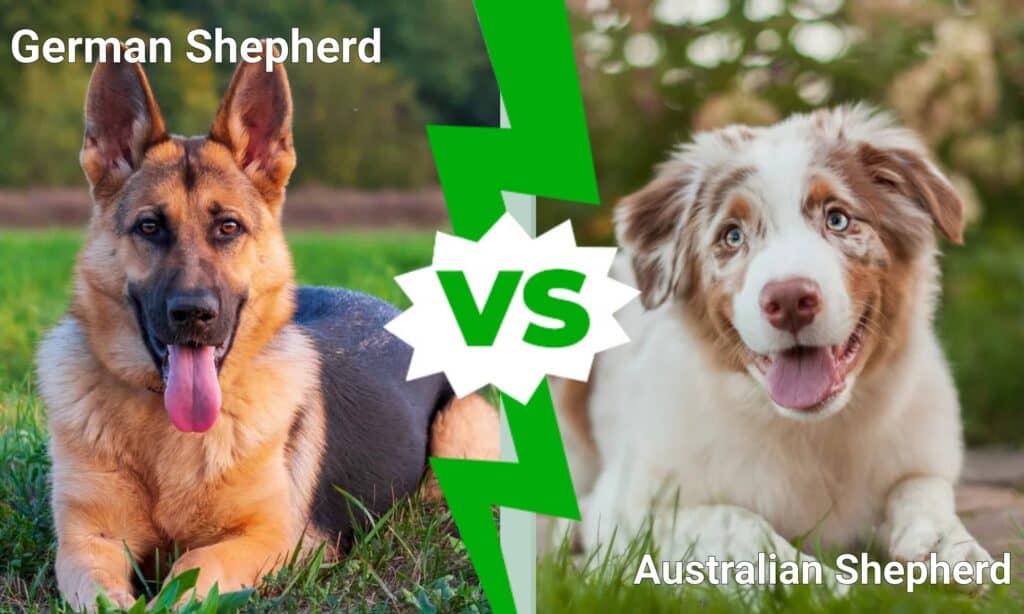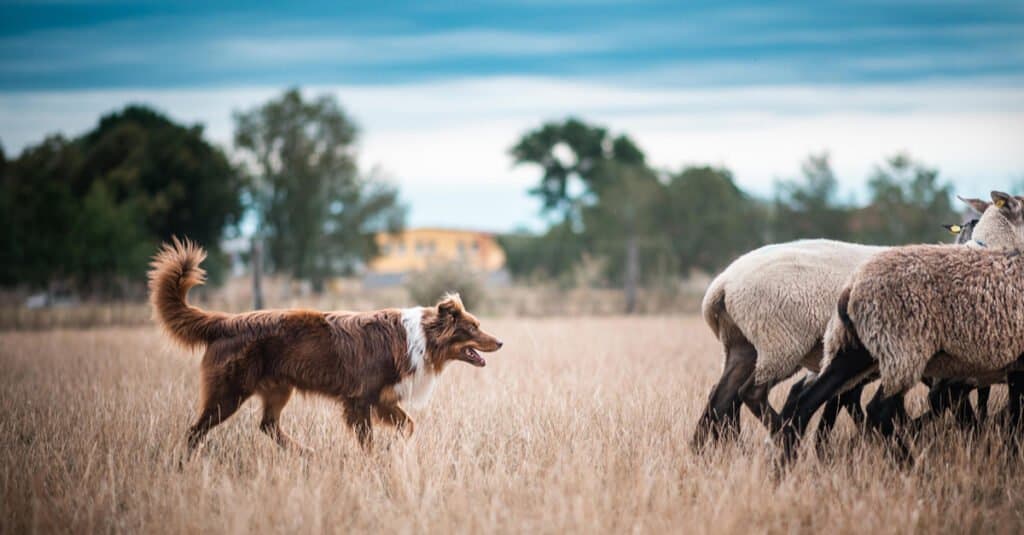Despite being medium-sized herding dogs, the German Shepherd vs Australian Shepherd are two unique breeds. They have different origins and distinct personalities. For example, Australian Shepherds are ranch dogs from the United States, but German Shepherds are native to Germany’s farming communities. To better understand these two loyal herding breeds, we’ll look at eight key differences between them.
German Shepherd vs Australian Shepherd: A Comparison

| Comparison | Australian Shepherd | German Shepherd |
|---|---|---|
| Height | 18 – 23 inches | 22 – 26 inches |
| Weight | 45 to 65 lbs. | 60 to 77 lbs. (males can weigh up to 90lbs.) |
| Coat type | Feathered, Average Shed | Fuzzy, Heavy Shed |
| Colors | Blue, Black, Merle, Red | Silver, Tan, Red, Black |
| Temperament | Active, Friendly, Smart, Loving | Alert, Obedient, Intelligent, Loyal |
| Biting Potential | Very Low | Very High |
| Life Expectancy | 12 to 14 Years | 10 to 13 Years |
| Health Problems | Cancer, Hypothyroidism, PRA | Blindness, Bloat, Paralysis, Lupus |
Key Differences Between German Shepherds and Australian Shepherds

The Australian Shepherd is known for its playful yet orderly nature, while German Shepherds are highly intelligent.
©Melounix/Shutterstock.com
There are many key differences between a German Shepherd vs Australian Shepherd. The German Shepherd is slightly larger than the Australian Shepherd, but both breeds are comparable in size. The Australian Shepherd comes in more colors and markings than the German Shepherd. Additionally, there are numerous differences between them, including their physical appearance, personality, and health. Let’s talk about those now.
Appearance

Male Australian Shepherds typically weigh 58 pounds whereas the German Shepherds are a larger breed, averaging 68 pounds.
©dezy/Shutterstock.com
German Shepherd vs Australian Shepherd: Height
Adult German Shepherds stand between 22 and 26 inches tall from paw to shoulder, whereas Australian Shepherds stand between 18 and 23 inches tall.
German Shepherd vs Australian Shepherd: Weight
Male Australian Shepherds typically weigh 58 pounds whereas the German Shepherds are a larger breed, averaging 68 pounds. Male German Shepherds can weigh up to 90 pounds while females average closer to 60 pounds and rarely exceed 70.

Australian Shepherds often have heterochromia, while German Shepherds do not.
©iStock.com/Bigandt_Photography
German Shepherd vs Australian Shepherd: Coat Type
Long and wavy, with a rich undercoat and coarse topcoat, is the Australian Shepherd’s fur. It’s short on the face and feathery on the back legs. The German Shepherd sheds far more than the Australian Shepherd because of its thicker, fluffier coat.
German Shepherd vs Australian Shepherd: Colors
Purebred Australian Shepherds typically come in four coat colors, which are black, blue merle, crimson, and red merle. The German Shepherd’s markings and coloring are more uniform. Their colors range from silver, tan, red, and black to a variety of hues. Black and tan are their most common colors. Australian Shepherds also often have heterochromia, while German Shepherds do not.
Characteristics

Purebred Australian Shepherds typically come in four coat colors, while German Shepherd’s markings and coloring are more uniform.
©Alpeek/Shutterstock.com
German Shepherd vs Australian Shepherd: Temperament
German Shepherds are very clever dogs who are relatively easy to teach. Once they trust, they are extremely devoted and faithful to their owners. As a result, they are frequently employed to assist the police. They do, however, like attention and can be rather fun because of their high level of activity and alertness. They are extremely affectionate and excellent with youngsters, yet they are cautious around other dogs.
Australian shepherds are a sociable and playful breed that gets along well with children and other animals. However, they typically prefer order and do not like their routine changed.
German Shepherd vs Australian Shepherd: Biting Potential
German Shepherds have a strong proclivity towards biting humans and other animals. This is not out of aggression, but rather to protect their master or themselves owing to their territorial nature. As a result, early training and socialization with humans and other pets are critical.
Australian Shepherds are gregarious and playful dogs who love to pursue anything they see as prey. However, unless provoked or threatened, they are not aggressive or known to bite.
Health Factors

While German Shepherds have a life expectancy of 10 to 13 years, Australian Shepherds have a lifespan of 12 to 14 years on average.
©TanyaCPhotography/Shutterstock.com
German Shepherd vs Australian Shepherd: Life Expectancy
German Shepherds have a life expectancy of 10 to 13 years, while Australian Shepherds have a lifespan of 12 to 14 years on average. With the right care and attention, both breeds have the potential to enjoy long and healthy lives.
German Shepherd vs Australian Shepherd: Health Problems
Australian Shepherds are prone to a variety of diseases, including nasal dermatitis, hip dysplasia, and epilepsy, among others. Cancer, hip dysplasia, paralysis, lupus, and progressive retinal atrophy are all potential health risks that any German Shepherd owner should be aware of. Because of these risks, it is usually a good idea to have your Shepherd’s eyes and hips checked on a regular basis.
Wrapping Up German Shepherd and Australian Shepherd

German Shepherds have a strong proclivity towards biting humans, while Australian Shepherds are more friendly overall.
©Ellis Berankova/Shutterstock.com
If you’re looking for a loyal, clever, and kid-friendly dog, you may want to consider one of these dogs. However, there are clear differences between these two breeds, including their biting potential as well as their coat colors. Hopefully, this article has supplied enough information to explain the differences between these two cute and faithful herding breeds.
The photo featured at the top of this post is © BIGANDT.COM/Shutterstock.com
Ready to discover the top 10 cutest dog breeds in the entire world?
How about the fastest dogs, the largest dogs and those that are -- quite frankly -- just the kindest dogs on the planet? Each day, AZ Animals sends out lists just like this to our thousands of email subscribers. And the best part? It's FREE. Join today by entering your email below.
Thank you for reading! Have some feedback for us? Contact the AZ Animals editorial team.






